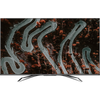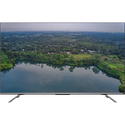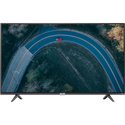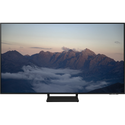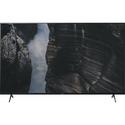A comparison of specs, key information, reviews, and best pricing from top retailers
Last updated -- hours ago | Report incorrect information
What we think

The PerfectRec TV team Learn more
Updated January 10, 2024·
If you prioritize overall picture quality, especially in both dark and bright rooms, and enjoy gaming, the Hisense U8G is a superior choice, though it is more expensive. This TV offers better contrast, higher peak brightness for HDR content, and more effective reflection handling. On the other hand, the Hisense U7H is more budget-friendly and still provides good picture quality, motion processing, and low input lag, making it suitable for a variety of content including gaming. However, it may not perform as well in very bright rooms, and its dark room performance is not quite as strong as the U8G. Give Feedback
this description is based on the product variant with some specs and product variant with some specs. At the time of writing, the variant with some specs cost some dollars and the variant with some specs cost some dollars.
Advantages of the Hisense U7H (LCD)
- The Hisense U7H (LCD) has no clear advantages over the Hisense U8G (LCD).
Advantages of the Hisense U8G (LCD)
- Very good for bright room
- Very good for gaming
- Very good for movies & TV
- Very good for cartoons & animation
- Good for use as monitor
- Very good reflections
Key differences
Movies & TV
7.4
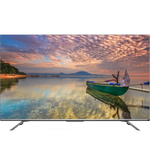
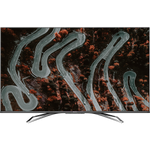
8.0
7.50/10
CONTRAST
7.63/10
5.7/10
BLACK UNIFORMITY
7.2/10
7.5/10
UPSCALING
7.5/10
Yes
HDR10 SUPPORT
Yes
Yes
HDR10+ SUPPORT
Yes
Yes
DOLBY VISION SUPPORT
Yes
The Hisense U8G (LCD) is very good for movies & TV, while the Hisense U7H (LCD) is good.
The Hisense U8G is favored for movie watching due to its superior black uniformity, which enhances viewing in dark scenes common in movies, along with a higher contrast ratio and more effective local dimming, contributing to deeper blacks and better shadow detail. While the Hisense U7H also performs well with a good contrast and local dimming, its lower black uniformity means that it may not represent dark scenes as accurately as the U8G, and it may exhibit more uneven colors and brightness across the screen.
Gaming
7.7


8.3
5.8/10
RESPONSE TIME SCORE
8.1/10
7.6/10
INPUT LAG SCORE
7.6/10
3.2/10
MOTION PROCESSING
3.9/10
75.0/100
GAMING LOCAL DIMMING
80.0/100
8.0/10
GAME HDR BRIGHTNESS SCORE
8.6/10
The Hisense U8G (LCD) is very good for gaming, while the Hisense U7H (LCD) is good.
The Hisense U8G is rated better for gaming than the Hisense U7H because it has a superior response time, which means it can display fast-moving content with less blurring. Both TVs have a similar input lag—which is how quickly a TV can display the image from a gaming console or PC—but the better response time of the U8G gives it an edge for gaming performance.
Cartoons & Animation
7.9


8.6
7.7/10
COLOR GAMUT SCORE
8.1/10
8.3/10
COLOR VOLUME SCORE
7.7/10
8.7/10
SDR BRIGHTNESS SCORE
8.8/10
6.5/10
COLORS OUT OF THE BOX SCORE
9.0/10
7.0/10
GRAY UNIFORMITY
6.4/10
The Hisense U8G (LCD) is very good for cartoons & animation, while the Hisense U7H (LCD) is good.
The Hisense U8G excels in presenting cartoons and animation due to its excellent color accuracy straight out of the box and a very good color gamut, which ensures a wide range of vibrant colors. While the Hisense U7H is also good for these types of content, its color performance is less impressive with only a fair out-of-box color accuracy, albeit its color gamut is still good.
News, Talk, & Other TV
8.1


8.6
8.7/10
SDR BRIGHTNESS SCORE
8.8/10
7.5/10
UPSCALING
7.5/10
The Hisense U8G (LCD) and Hisense U7H (LCD) are both very good for news, talk, & other TV, though the Hisense U8G (LCD) is somewhat better.
The Hisense U7H and U8G both excel at upscaling lower-resolution content to their 4K screens and offer high SDR brightness, making them suitable for watching news and TV programs. While the U7H performs well with colors straight out of the box and has a good color gamut enhancing the picture quality, the U8G slightly outpaces it with excellent color accuracy out of the box and a very good color gamut, providing a more vibrant and true-to-life viewing experience.
Bright Room
7.7


8.9
5.4/10
VIEWING ANGLE
5.3/10
8.7/10
SDR BRIGHTNESS SCORE
8.8/10
7.5/10
HDR BRIGHTNESS SCORE
8.4/10
6.6/10
REFLECTIONS SCORE
8.6/10
The Hisense U8G (LCD) is very good for bright room, while the Hisense U7H (LCD) is good.
The Hisense U7H has very good SDR brightness and adequate reflection handling that makes it suitable for bright rooms. However, the Hisense U8G not only matches the U7H in SDR brightness but also offers very good reflections handling, resulting in a slightly better viewing experience in brightly lit environments.
Cost
$698


$971
$200
$400
$600
$800
$1,000
$1,200
$1,400
$1,600
The Hisense U7H (LCD) has a price of $698 and the Hisense U8G (LCD) costs $971.

Let Us Help Find Your Perfect TV
Find your new TV
Key similarities
Picture Quality
7.6


8.0
7.50/10
CONTRAST
7.63/10
8.3/10
COLOR VOLUME SCORE
7.7/10
LED FALD
PANEL TYPE
LED FALD
VA
PANEL SUB-TYPE
VA
Although they have very similar scores, PerfectRec considers Hisense U8G (LCD) to have very good picture quality, while the Hisense U7H (LCD) has good picture quality.
Sports
6.0


6.4
3.2/10
MOTION PROCESSING
3.9/10
120Hz
REFRESH RATE
120Hz
7.6/10
INPUT LAG SCORE
7.6/10
7.5/10
UPSCALING
7.5/10
8.7/10
SDR BRIGHTNESS SCORE
8.8/10
Yes
HLG SUPPORT
Yes
The Hisense U8G (LCD) and Hisense U7H (LCD) are both only fair for sports.
The Hisense U7H has poorer motion processing and slower response time compared to the Hisense U8G, making the latter a slightly better option for sports; however, both have issues with reflections handling and limited viewing angles which can be a drawback for bright rooms and wider seating arrangements.
Give feedback
We’re constantly working to improve.
How the Hisense U7H (LCD) and the Hisense U8G (LCD) compare to other TVs
Spec Comparison
| Hisense U7H (LCD) | Hisense U8G (LCD) |
GENERAL | |||
|---|---|---|---|
| Price | |||
$698 | $971 | ||
Brand | |||
Brand | Hisense | Hisense | |
Release Date | |||
Release Date | August 2, 2022 | May 2, 2021 | |
Full name | |||
Full name | 65U7H | 65U8G | |
Screen Size | |||
Screen Size | 65" | 65" | |
Screen Resolution | |||
Screen Resolution | 4K | 4K | |
TV FEATURES | |||
|---|---|---|---|
Operating System | |||
Operating System | Google TV | Android TV | |
Sound Quality Score | |||
Sound Quality Score | 7.5/10 | 7.5/10 | |
NextGen Ready | |||
NextGen Ready | Yes | No | |
HDMI Ports | |||
HDMI Ports | 4 | 4 | |
Coax Ports | |||
Coax Ports | 1 | 1 | |
DISPLAY QUALITY SCORES | |||
|---|---|---|---|
Picture Quality Score | |||
Picture Quality Score | 7.6/10 | 8.1/10 | |
Bright Room Score | |||
Bright Room Score | 7.7/10 | 8.9/10 | |
Gaming Score | |||
Gaming Score | 7.7/10 | 8.3/10 | |
Movies & TV Score | |||
Movies & TV Score | 7.4/10 | 8.1/10 | |
Sports Score | |||
Sports Score | 6.1/10 | 6.4/10 | |
PHYSICAL | |||
|---|---|---|---|
Dimensions w/o Stand (H x W x D) | |||
Dimensions w/o Stand (H x W x D) | 33.1" x 57" x 3.5" | 33.1" x 57.1" x 4.1" | |
Dimensions with Stand (H x W) | |||
Dimensions with Stand (H x W) | 35.5" x 57" | 35.6" x 57.1" | |
Weight without Stand | |||
Weight without Stand | 43.0 lbs | 53.4 lbs | |
VESA Mount | |||
VESA Mount | 300 x 200 | 400 x 400 | |
DISPLAY | |||
|---|---|---|---|
Color Depth | |||
Color Depth | 10 bit | 10 bit | |
Black Frame Insertion | |||
Black Frame Insertion | Yes | Yes | |
Auto Low Latency Mode | |||
Auto Low Latency Mode | Yes | Yes | |
Contrast | |||
Contrast | 7.5/10 | 7.6/10 | |
Local Dimming | |||
Local Dimming | 7/10 | 8/10 | |
SOUND | |||
|---|---|---|---|
Speaker Setup | |||
Speaker Setup | 2.0 | 2.0 | |
Speaker Power | |||
Speaker Power | 20 W | 20 W | |
Dolby Atmos | |||
Dolby Atmos | Yes | Yes | |
DTS:X | |||
DTS:X | Yes, Bypass only | Yes, Bypass only | |
Shopping
Hisense U7H (LCD)
See more
Dig into reviews and images
Tom's guide
Christian de Looper | December 2022
"We loved the Hisense U7H. It was able to deliver an excellent all-around image quality in its price range. The TV excels at controlling its backlighting in a way that ensures you’ll never experience blooming to a level of being distracting, something that I was a little surprised to see given the lack of Mini LED. The TV doesn’t just get decently bright it offers relatively accurate color reproduction for a TV in this price range. The TV is being billed excellent for gaming."
Get a great deal on the Hisense U7H (LCD) or the Hisense U8G (LCD)
About Hisense
Hisense, a Chinese TV manufacturer, entered the US market in approximately 2011 and has since acquired TV divisions from various companies such as Toshiba, Sharp, Hitachi, and NEC. Currently ranking as the fourth largest vendor in terms of sales volume, Hisense aims to capture a wide range of TV budget segments. They offer exceptional value with TVs that often outperform their competitors at similar price points, making them a compelling choice for consumers. In the US, they use Google TV as their smart TV software which provides the largest app selection and a very modern user interface, however it is not as user friendly as the software from other vendors.
Give feedback
We're constantly perfecting our model
TV guides you might be interested in
More comparisons for you
FAQs
FAQs about TVs
Why trust us
This information was produced and vetted by the PerfectRec TVs team. We are a product research and recommendation organization that meticulously reviews and evaluates the latest TV information and makes it digestible for you.
By the numbers
385
TVs evaluated
33,110
TVs stats compiled
21
Proprietary TVs ratings developed
179,130
Recommendations made
26,870
Consumer hours saved
About the TV team
Joe Golden, Ph.D
CEO and TVs Editor
Joe is an entrepreneur and lifelong electronics enthusiast with a Ph.D in Economics from the University of Michigan.
Jason Lew
Staff Expert & Software Engineer
Jason is a staff expert and software engineer that has been making laptop recommendations for 7 years and moderates one of the largest laptop subreddits.
Chandradeep Chowdhury
Staff Expert & Software Engineer
Chandradeep is a staff expert and software engineer and expert in televisions and monitors. He’s been making monitor recommendations for ten years.
Jaime Roldán
TVs Expert
Jaime is a Colombia-based TV expert. He is an electronics engineer with 8 years of experience in the telecom sector and has been making TV recommendations for 12 years.

